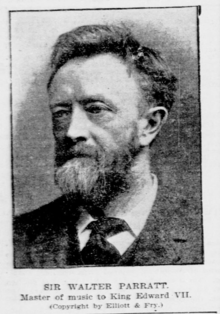Walter Parratt
Sir Walter Parratt KCVO (10 February 1841 – 27 March 1924) was an English organist and composer.[1]
Sir Walter Parratt KCVO | |
|---|---|
 | |
| 14th Master of the King's Musick Master of the Queen's Musick (1893–1901) | |
| In office 1 June 1893 – 27 March 1924 | |
| Monarch | Victoria Edward VII George V |
| Preceded by | William Cusins |
| Succeeded by | Edward Elgar |
| Personal details | |
| Born | Walter Parratt 10 February 1841 Huddersfield, West Yorkshire, England |
| Died | 27 March 1924 (aged 83) |
| Alma mater | Magdalen College, Oxford |
Biography
Born in Huddersfield, son of a parish organist, Parratt began to play the pipe organ from an early age, and held posts as an organist while still a child. He was child prodigy: on one occasion he played Bach's complete The Well-Tempered Clavier by heart, without notice, at age ten.[2]
From 1854 to 1861 he was an organist at St Paul's Church in his native town and, as successor to John Stainer, in 1872 at Magdalen College, Oxford, where he remained for ten years. From 1882 he held the post of organist of St. George's Chapel, Windsor Castle. He became Heather Professor of Music at Oxford University in 1908, taking over from Hubert Parry.
He became one of the foremost organ teachers of his day, with many important posts in Britain being filled by his students. He was president of the Royal College of Organists.
Parratt was also a distinguished chess player, and was able to simultaneously play chess and a complex organ piece—at first sight.[3] He served for a few months as president of the Oxford University Chess Club and for two years was captain of the eight chosen to play against Cambridge.[4]
Honours
He was knighted in 1892. In 1893 he was appointed Master of the Queen's Musick to Queen Victoria, and afterward held the same office under Kings Edward VII[5] and George V.
Later honours included: Member (MVO, 1901), Commander (CVO, 1917), and Knight Commander (KCVO, 1921) of the Royal Victorian Order.
After Parratt's death in 1924 a monument to him was erected in the grounds of Huddersfield Parish Church. There is also a monument to him in St George's Chapel, Windsor Castle, next to the entrance to King George VI Memorial Chapel where King George VI and the Queen mother are buried.
Appointments
- Armitage Bridge Church, 1852-1854
- St. Paul's Church, Huddersfield, 1854-1861
- private organist to the Earl of Dudley, Witley Court, 1861-1868
- organist of Wigan Parish Church, 1868-1872
- Magdalen College, Oxford, 1872-1882
- St. George's Chapel, Windsor Castle 1882-1924
See also
Notes
- "Obituary: WALTER PARRATT". Musical Times. 65: 401–403. 1 May 1924. JSTOR 913981.
- Grove's Dictionary, 5th edition, 1954, Vol. 6, p. 559
- Pearson, Arthur (June 1903). "Famous Yorkshire Musicians". The Non-Conformist Musical Journal. 186: 73, 88–90. Retrieved 2010-03-24.
- "PARRATT, Sir Walter". Who's Who. Vol. 59. 1907. p. 1359.
- "No. 27363". The London Gazette. 8 October 1901. p. 6569.
References
- Rosemary Firman, 'Parratt, Sir Walter (1841–1924)', Oxford Dictionary of National Biography, Oxford University Press, 2004 accessed 25 March 2008
- Donald Tovey & Geoffrey Parratt, Walter Parratt: Master Of The Music (Oxford University Press, 1941).
- Organ Recitals at St George's Chapel
External links
| Court offices | ||
|---|---|---|
| Preceded by Sir William Cusins |
Master of the Queen's (later King's) Musick 1893–1924 |
Succeeded by Sir Edward Elgar |